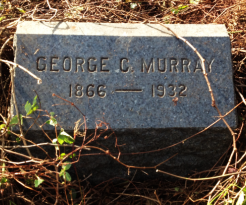Title: Roofer, philanthropist
Birthdate: June 1, 1866
Death Date: November 17, 1932
Plot Location: Section 110, Lot 24

Most people think a philanthropist has more money than they can spend, but that’s not the correct definition. The reason “hundreds” mourned  his death, according to this headline, is that George proved the old saying, “It’s not how much you make but what you do with it that counts.”
his death, according to this headline, is that George proved the old saying, “It’s not how much you make but what you do with it that counts.”
He was the middle child of seven, with three older brothers and three younger sisters. They grew up in the Mantua neighborhood of West Philadelphia where their father’s business was located.
William Murray was a tinsmith, specifically in the roofing business. It was the same career three of  his four sons chose to pursue. When he died in 1887 his company was called “William Murray & Son,” referring to his oldest son, John, but William Jr. and George also worked for him as roofers. George’s other brother, Robert, chose a career that was less demanding, physically, as an insurance agent.
his four sons chose to pursue. When he died in 1887 his company was called “William Murray & Son,” referring to his oldest son, John, but William Jr. and George also worked for him as roofers. George’s other brother, Robert, chose a career that was less demanding, physically, as an insurance agent.
Tin-plated iron or steel, commonly called tin roofing, was the most common roofing material in the late 19th century. It was a low-cost, low-maintenance, and lightweight product, often painted red or in a color to imitate the green patina of copper.
The three older sons married and lived the rest of their successful lives in Philly, but George moved to Doylestown at the turn of the century and remained single. Not long after he arrived he started a local unit of the Boys’ Brigade. Founded in Scotland in 1883, it was the world’s first uniformed youth organization, out of which grew the Boy Scouts.
To the boys he was known as Captain Murray. Over the course of 30 years the name stuck.
What little he had he spent to help pay the electric and heating bill at a local recreation center. Then he found ways to make it possible for boys to attend summer camp, which included more of his own money. He gave of his funds when he could, but the most valuable gift was his time, teaching character, discipline, respect, and integrity.
 He was on the job as a roofer when he fell from the top of a building and fractured his skull. He died at a hospital in Montgomery County, and was buried here with the rest of his family. Around this handsome obelisk are individual stones, like the one for George, shown above.
He was on the job as a roofer when he fell from the top of a building and fractured his skull. He died at a hospital in Montgomery County, and was buried here with the rest of his family. Around this handsome obelisk are individual stones, like the one for George, shown above.
 He may have had only one brother left to eulogize him, but he also had a grateful community. This newspaper obituary recognized that a person doesn’t have to be rich to be a philanthropist, but in his giving he is far richer. A father of one of those hundreds of boys that benefited from knowing George said this to the reporter, who concluded there would be no more fitting epitaph:
He may have had only one brother left to eulogize him, but he also had a grateful community. This newspaper obituary recognized that a person doesn’t have to be rich to be a philanthropist, but in his giving he is far richer. A father of one of those hundreds of boys that benefited from knowing George said this to the reporter, who concluded there would be no more fitting epitaph:


Support the Friends of Mount Moriah
Help us in our mission to restore and maintain the beautiful Mount Moriah Cemetery by donating to our cause or volunteering at one of our clean-up events.

